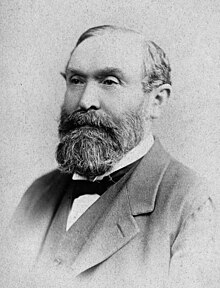William Rutherford (physiologist)


William Rutherford
Life
Rutherford was born at Ancrum Craig Farm near Ancrum in Roxburghshire, the son of Elizabeth (née Bunyan) Thomas Rutherford, a farmer and landowner. He was educated at Jedburgh Grammar School then studied medicine at the University of Edinburgh, gaining his doctorate (MD) in 1863.[2]
After studying in
In 1869 he was elected a fellow of the Royal Society of Edinburgh, his proposer being John Hughes Bennett.[2]
In 1869 Rutherford became assistant professor of physiology at
Rutherford lectured at the University of Edinburgh when Arthur Conan Doyle studied medicine there. Like his fictional character Sherlock Holmes, who was based on a real person, Conan Doyle's Professor Challenger was based in part on Rutherford.[8] From 1881 his laboratory assistant was Sutherland Simpson.
He died 21 February 1899 at 14 Douglas Crescent, Edinburgh.[9] He was not married and had no children, so he was buried with his parents in Ancrum parish churchyard.[10]
His chair at the University was filled by Prof Edward Albert Sharpey-Schafer.[11]
Works
- On the morbid appearances met with in the brains of thirty insane persons, 1869
- Influence of the vagus upon the vascular system, 1869
- Introductory lecture to the course of physiology in King's College, London, 1869, 1869
- An introduction to the study of medicine : a lecture delivered at the opening of the medical session of 1871–72, in King's College, London, 1871
- The present aspects of physiology; an introductory lecture, 1874
- Outlines of practical histology : being the notes of the Histological Section of the Class of Practical Physiology held in the University of Edinburgh, 1875
- The sense of hearing: a lecture, 1886
- Syllabus of lectures on physiology, 1887
- A General account of histological methods, 1887
- On the conditions that influence the attainment of the physiological ideal : introductory lecture, 14 October 1890, 1890
- The tercentenary of the compound microscope; an inaugural address delivered 7 November 1890, to the Scottish Microscopical Society, 1891
- On the method of studying a natural science such as physiology : an introductory lecture, delivered 9 October 1894, 1894
Notes
- ISBN 978-0-902198-84-5. Archived from the original(PDF) on 5 April 2019. Retrieved 15 December 2011.
- ^ ISBN 0-902-198-84-X. Archived from the original(PDF) on 4 March 2016. Retrieved 9 May 2018.
- ^ doi:10.1038/059590a0..
- ISBN 978-0262019507.
- ^ Minute Books of the Harveian Society. Library of the Royal College of Physicians of Edinburgh.
- ^ Watson Wemyss, Herbert Lindesay (1933). A Record of the Edinburgh Harveian Society. T&A Constable, Edinburgh.
- ^ Minute Books of the Aesculapian Club. Library of the Royal College of Physicians of Edinburgh.
- ^ In Memories and Adventures Doyle writes 'Most vividly of all, however, there stands out in my memory the squat figure of Professor Rutherford with his Assyrian beard, his prodigious voice, his enormous chest and his singular manner. He fascinated and awed us. I have endeavoured to reproduce some of his peculiarities in the fictitious character of Professor Challenger. He would sometimes start his lecture before he reached the classroom, so that we would hear a booming voice saying: "There are valves in the veins," or some other information, when the desk was still empty. He was, I fear, a rather ruthless vivisector, and though I have always recognized that a minimum of painless vivisection is necessary, and far more justifiable than the eating of meat as a food, I am glad that the law was made more stringent so as to restrain such men as he. "Ach, these Jarman Frags!" he would exclaim in his curious accent, as he tore some poor amphibian to pieces.'
- ^ Edinburgh Post Office Directory 1899
- ^ Lee, Sidney, ed. (1901). . Dictionary of National Biography (1st supplement). London: Smith, Elder & Co.
- ^ "Frontiers Magazine | Sutherland Simpson: From Saraquoy to Cornell". Retrieved 24 September 2021.
References
- Richards, Stewart (May 1986). "Conan Doyle's 'Challenger' Unchampioned: William Rutherford, F.R.S. (1839–99), and the Origins of Practical Physiology in Britain". Notes and Records of the Royal Society of London. 40 (2). The Royal Society of London: 193–217. S2CID 20786841.
External links
- Notes and Laboratory records of Professor William Rutherford (1839–1899), and Notes from Lectures given by Rutherford and taken down by others, held at the Edinburgh University Library, Special Collections Division
